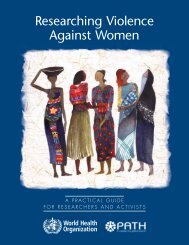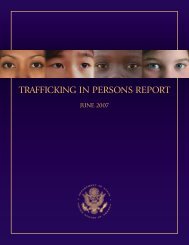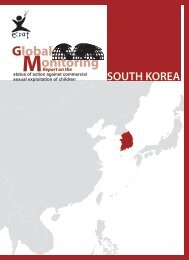Download PDF - Violence Against Children - East Asia and the ...
Download PDF - Violence Against Children - East Asia and the ...
Download PDF - Violence Against Children - East Asia and the ...
Create successful ePaper yourself
Turn your PDF publications into a flip-book with our unique Google optimized e-Paper software.
ecommendations<br />
Recommendations<br />
All examples of useful practice detailed in <strong>the</strong><br />
different chapters (especially under <strong>the</strong><br />
“Useful approaches” headings) can be viewed<br />
as recommendations for change.<br />
In addition, <strong>the</strong> following recommendations –<br />
which are clustered under <strong>the</strong> same headings as<br />
used in <strong>the</strong> CAN study – are targeted at those<br />
who implement or support programs to<br />
address children at risk. Emphasis is placed on<br />
practical ways to build on initiatives that are<br />
already active in many communities.<br />
Project design supporting families<br />
<strong>and</strong> building community<br />
• Recognise <strong>and</strong> support <strong>the</strong> family as <strong>the</strong><br />
principal agent for <strong>the</strong> protection of<br />
children <strong>and</strong> <strong>the</strong> fulfilment of children’s<br />
development <strong>and</strong> potential.<br />
• Ensure that <strong>the</strong> concept of “community”<br />
includes vulnerable or hidden members.<br />
• Promote local ownership of child<br />
protection <strong>and</strong> expectation/commitment for<br />
its implementation through partnerships,<br />
community organising <strong>and</strong> a broad range of<br />
involvements. Recognise that local concern<br />
about child protection already exists – it<br />
may just need resourcing <strong>and</strong> mobilising.<br />
• Pursue effective application of common<br />
principles of <strong>the</strong> CRC, as <strong>the</strong>se can give<br />
hope <strong>and</strong> value to children. Identify <strong>and</strong><br />
engage on areas of priority, as reflected<br />
in <strong>the</strong> aspirations of children <strong>and</strong> as noted<br />
by <strong>the</strong> country mechanisms monitoring<br />
implementation of <strong>the</strong> CRC.<br />
• Engage families <strong>and</strong> <strong>the</strong> community to<br />
broaden <strong>the</strong>ir underst<strong>and</strong>ing on issues<br />
affecting children by integrating activities<br />
with a clear social justice element. Include<br />
in program design provision <strong>and</strong> “space” to<br />
underst<strong>and</strong> <strong>and</strong> influence local attitudes<br />
that restrict child development. 5<br />
To mobilise community members on child<br />
protection, use materials that are effective<br />
<strong>and</strong> meaningful in <strong>the</strong> local context, highly<br />
visual <strong>and</strong> with easy to underst<strong>and</strong> text.<br />
Ensure that <strong>the</strong> materials are linked to<br />
follow-up.<br />
• Include as activities in program designs,<br />
specific strategies linked to child protection<br />
aims. Child protection responses should<br />
prioritise prevention efforts that reduce<br />
<strong>the</strong> violence children are subject to,<br />
increase access to <strong>and</strong> quality of education,<br />
<strong>and</strong> promote economic activity.<br />
• Reach more children through communitybased<br />
ra<strong>the</strong>r than centre-based<br />
prevention <strong>and</strong> early intervention programs.<br />
• Identify practical child protection measures<br />
that will maximise opportunities to<br />
support, <strong>and</strong> counter constraints to, <strong>the</strong><br />
implementation of local <strong>and</strong> national policy.<br />
• In settings with highly mobile populations or<br />
problems of human trafficking, set<br />
indicators to monitor mobility as a<br />
push–pull factor that places children at risk.<br />
• In relief efforts, include child protection as<br />
a key area of response alongside sectors<br />
such as health, education <strong>and</strong> shelter.<br />
• In situations of recent, present or potential<br />
conflict, ensure that community<br />
development supports peace building <strong>and</strong><br />
trust. Focus on processes, not only on<br />
outcomes, to ensure that any development<br />
initiative does not become a liability leading<br />
to fur<strong>the</strong>r tension.<br />
• Make active use of curricular tools that<br />
promote peace building <strong>and</strong> awareness of<br />
<strong>the</strong> CRC in schools; education has been<br />
highlighted as a key entry point to a<br />
community where children are marginalised<br />
<strong>and</strong> at risk.<br />
• Increase livelihood options of families <strong>and</strong><br />
children, to reduce <strong>the</strong> debilitating effects<br />
<strong>and</strong> risk factors of poverty.<br />
• Link project activities that seek to build<br />
social capital with existing community<br />
organisations <strong>and</strong> support <strong>the</strong>ir<br />
development. Civil society goes beyond<br />
NGOs <strong>and</strong> includes groups such as<br />
churches, residents’ associations <strong>and</strong><br />
5<br />
For example, a common view in Indonesia is “more children, more benefit”, but on <strong>the</strong> negative side, some parents do not think of <strong>the</strong> need for<br />
appropriate education <strong>and</strong> health care. Likewise, <strong>the</strong> Cambodian saying that “children need to pay back <strong>the</strong> breast milk” can be used to justify actions that<br />
place children at risk through hazardous labour. The LICADHO approach in Cambodia seeks to help parents to better differentiate between child labour<br />
<strong>and</strong> hazardous child labour.<br />
85

















